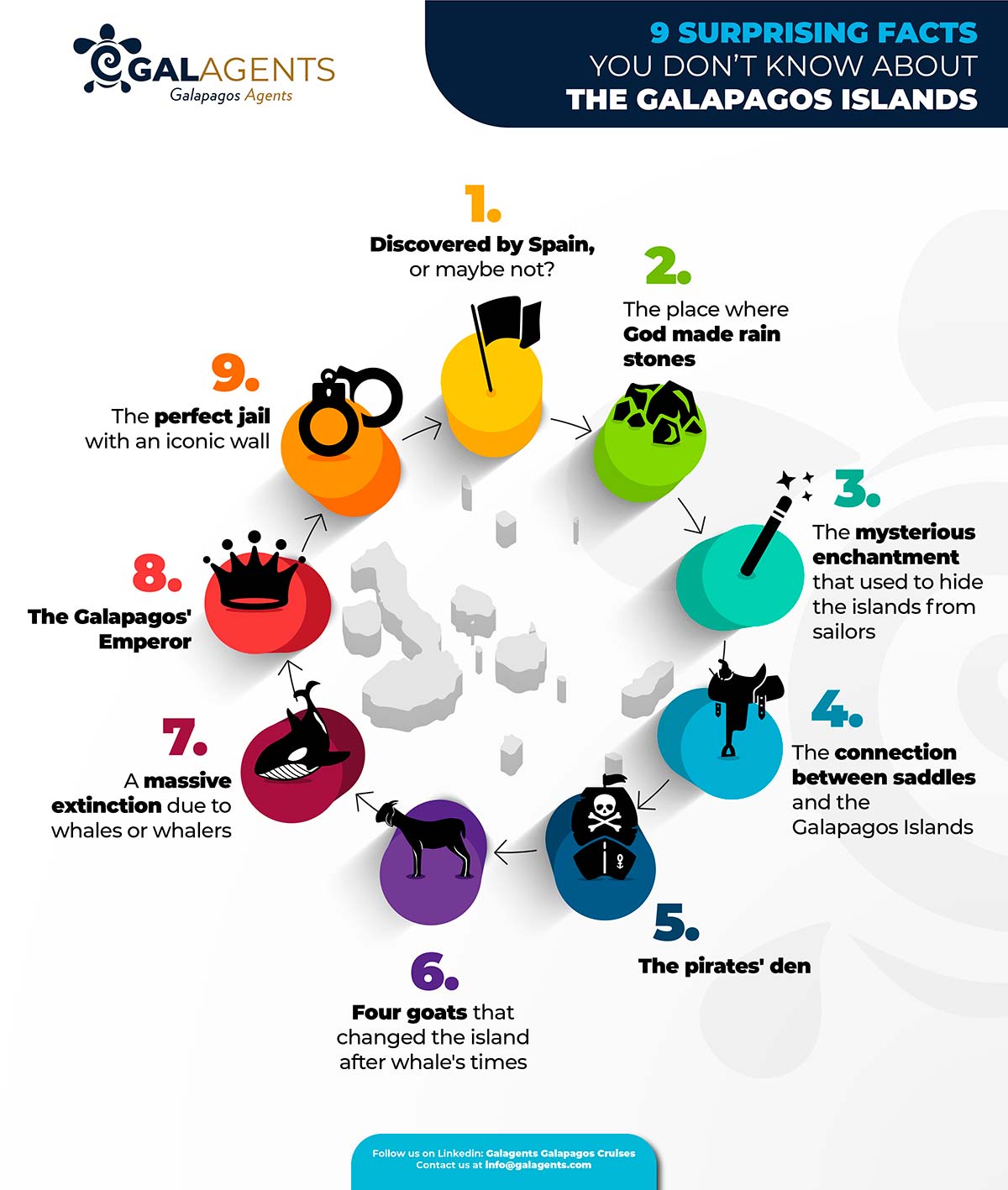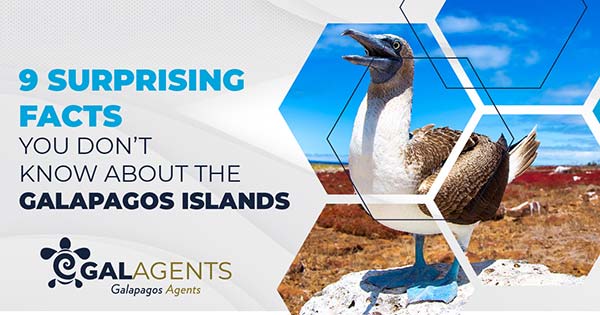What would you answer if we asked you about the Galapagos Islands? We´re pretty sure that you will talk about Darwin´s Theory of Evolution, the rare animals, or about the fact it´s an exotic destination, aren´t you?
However, in this article, we´re bringing you some fun facts you may not know, so you can either be the clever one in a friendly meeting or share it with your clients to let them see the uniqueness of this remote archipelago in the Pacific Ocean.
1- Discovered by Spain or maybe not?
According to history, Spaniards discovered the Galapagos Islands. Yet, some scientists claim another theory about the Incas being the first ones that find the archipelago under the lead of Tupac Yupanqui. However, no evidence supports this hypothesis.
What do you think about it? Spaniards or Incas?
2- The place where God made rain stones
Aside from the Inca´s theory, what we´re sure of is that March 10th, 1535, is the day that a Spaniard ship anchored on a remote island during its journey from Panama to Peru.
Fray Tomás de Berlanga, Panama´s archbishop, was traveling to Peru after the mandate of King Charles V when the currents dragged the ship to the unknown archipelago up to that time.
Fray Tomas said these islands were ugly and arid, where God made rain stones, making the land infertile. Strangely, the islands had many turtles, sea lions, and birds that Fray Tomas said were so clumsy that they couldn´t even fly.
Without a doubt, Fray Tomas made a good statement about the Galapagos rocky fields.
3- The mysterious enchantment that used to hide the islands from sailors
The Galapagos Islands were surrounded by strong currents and thick fog that usually hid the islands from the ships. That´s why Captain Diego Rivadeneira named the Galapagos the Enchanted Islands. Indeed, mariners thought that the islands floated along the ocean, making them appear and disappear. Could you imagine that?

4- The connection between saddles and the Galapagos Islands
We all know, and if not, you´ll know now, that the islands were named after the giant tortoises called Galapagos. However, you may not know that the tortoises were called like that because the tortoiseshell looked like saddles to the sailor´s eyes.
Galapagos was a Spanish word used in Central America to refer to female saddles.
Do you think the giant tortoise´s shells look like feminine horseback saddles?
5- The pirates´ den
The Spanish crown was well known for the tons of gold that it took from its colonies in the “New World.” Hence, the Spanish ships were easy targets for pirates who wanted to steal precious gold.
The Galapagos Islands then became a strategic place close to the ship routes and too far from the mainland to be caught by the Spanish crown navy.
The islands became famous after the navigation map drawn by Ambrose Cowley in 1684, a crew member from the Bachelor´s Delight buccaneer captained by John Cook, which had to anchor at Santiago Island looking for refuge because Cook was sick. Nowadays, this place is called Buccaneer Cove.
6- Four goats that changed the island after whale’s times
After the gold started to lose importance in the 18th century, whale oil became the new gold, so the English Captain James Colnett was sent to the archipelago to find out the potential the islands had for hunting whales.
Colnett made a new sail map of the Galapagos that helped whalers come to the archipelago to hunt whales until the early 19th century. Then, the US Frigate Essex captured many whalers but unfortunately left four goats on Santiago Island, which later became an invasive species that threatened the local fauna.
Moreover, did you know that, apparently, Colnett was the one that established the Post Office on Floreana Island?
The good part of this story is that visitors can visit nowadays the Post Office when they are cruising the southern side of the archipelago.
7- A massive extinction due to whales or whalers
The Galapagos Islands were an important whale station until Japan built its whaler base in 1819, fortunately for the Galapagos´ fauna.
During the Galapagos whale period, sea lions were almost extinct from the archipelago, while the giant tortoises were hunted for being a good food source. In fact, according to whaler’s binnacle, in more than 30 years (1811 – 1844), around 15,000 tortoises were killed.
8- The Galapagos’ Emperor
The remoteness of the Galapagos archipelago was its hook for being a coveted destination for those that wanted to build their empire.
You may have heard about the Austrian Baroness Eloise Wehrborn de Wagner-Bosquet and her two lovers. She wanted to build a hotel in Floreana and disturb the “peace” of the first settlers, the Wittmer and Ritter families. Would you like us to talk about them more in-depth? Let us know in the comments.
However, only three decades after the visit of Charles Darwin, an Ecuadorian landlord called Manuel Cobos moved to San Cristobal Island and built a sugar cane factory.
He settled in San Cristobal, brought farmers, and built a train line to transport the sugar cane to the harbor. Yet, the most disturbing were the inhuman conditions with its farmers, who suffered harsh punishments if they didn’t do what Cobos wanted. Some of them were banished to desert islands and left to die.
Cobos was so important that he had his currency called “Progreso,” established a system to bring water from the volcano to live and produce sugar, and brought European technology to produce sugar and export it. In that period, he was the most important person in San Cristobal and was known as the Galapagos’ Emperor!
What do you think happened with Cobos? Well, he was killed by his farmers, or better to call them enslaved people.
9- The perfect jail with an iconic wall
After years of colonizing intentions, some more successful than others, the Galapagos was also the perfect spot for being a penal colony due to its remoteness and harsh conditions. So, between the ’40s and the ’50s, in the XX century, Isabela was the perfect jail for those that needed punishment.
Just imagine that escape from there was almost impossible.
Would you swim more than 1000 km in a sea infested by sharks? Probably not!
Prisoners in Isabela lived in precarious conditions and were forced to do exhausting manual labor, such as building a wall as high and wide as possible with heavy volcanic stones. That wall is called the Wall of Tears, which measures 100 m (328 ft) and it’s around 6 m high (approx. 20 ft).
Nowadays, Tourists can visit this wall by walking or biking from Puerto Villamil. Here, you will see and feel the sad vibe of the wall and the concrete base left by the US Army when they built their wood houses during their occupancy in World War II.
How many of these facts did you know? Or which one surprised you the most? Let us know in the comment, and hopefully, you will have some fun facts about the Galapagos Islands to share with your clients or friends.
Sources:

